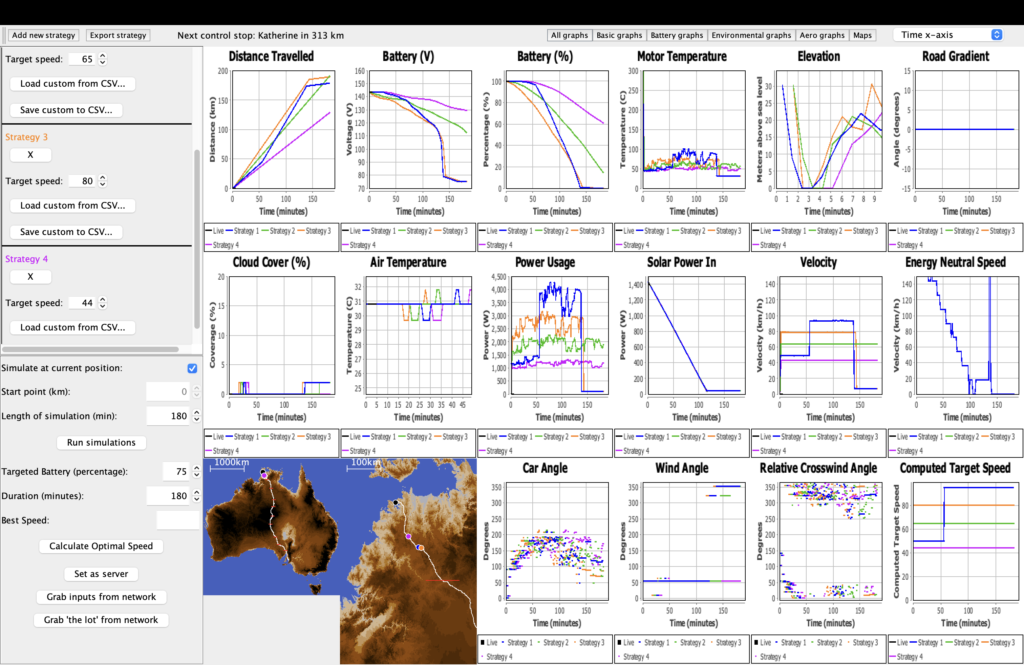Leveraging Tomorrow.io API for Solar Racing: A Deep Dive into Weather Data Integration
By Nurhan Raihan, 14 September 2023
In the world of solar racing, where innovation and precision are paramount, having access to real-time and accurate weather data can make all the difference. To shed light on how the Tomorrow.io Weather API (https://www.tomorrow.io/weather-api) has been harnessed to download crucial weather information, we sat down with the members of the solar racing software team responsible for working on the weather implementation – Richard, Jiayu, and Alex. They shared insights into their roles, the challenges they’ve encountered, and the future of their Tomorrow.io API integration.
The Tomorrow.io API provides comprehensive weather data, including temperature, cloud cover, wind speed, and wind direction, at a granular level. This data is essential for the solar racing software team to accurately predict the vehicle’s speed, power consumption, and overall performance during on their race on the Bridgestone World Solar Challange (BWSC). This is a 3022km race through the Australian outback, from Darwin to Adelaide, that must be made entirely on solar power. By integrating the Tomorrow.io API, the team can make data-driven decisions that optimize the solar vehicle’s performance under any weather condition.

Weather data from Tomorrow.io is used in the team’s simulation software to predict conditions on the race
The team leverages the Tomorrow IO API to access both live and forecasted weather data. Live weather data is used to make real-time decisions about the vehicle’s speed and route, while forecasted weather data is used to plan for future challenges. The team has developed a sophisticated algorithm for downloading and processing weather data from the Tomorrow.io API. This algorithm ensures that the team always has access to the most up-to-date weather information, even when internet connectivity is intermittent.
Collaboration within the team
Alex serves as the lead of the solar racing software team, with a primary focus on the simulation aspect. His responsibilities include overseeing the simulation team and the software that powers the race, with a special emphasis on integrating the Tomorrow.io API for accessing up-to-date weather data. Another team member, Richard notes that the Tomorrow IO API was chosen for its exceptional data quality, which is essential for accurately modeling the solar vehicle’s performance under varying weather conditions.
The simulation software is a collaborative project by the team. Jiayu, a vital team member, played a pivotal role in implementing the Tomorrow.io API integration. She initially focused on the basic download and its integration within the simulation. Later, Richard and Alex made improvements to integration, including the ability to save data for future reference. Jiayu and Richard’s contributions have been essential to the team’s success in leveraging the Tomorrow.io API to enhance their solar racing simulation.
Handling Multiple Locations’ Data
The team often needs to retrieve weather data for multiple locations along the solar racing route. To address this challenge, the team employs a simulation that predicts each location’s weather conditions in the next five hours. This information is then used to pass coordinates to the Tomorrow.io API and retrieve relevant data for each location in an hourly time frame. The team’s simulation is able to handle a large number of locations with minimal performance impact. This algorithm takes into account factors such as the distance between the locations, the availability of internet connectivity, and the team’s bandwidth constraints.

Effective Data Presentation
The team’s solar racing simulation includes a variety of features for visualizing and interacting with weather data. For example, the simulation includes graphs that display temperature, wind direction, wind speed, and cloud coverage. Each graph features a live data line for real-time predictions. This allows the team to quickly assess and respond to changing weather conditions.
Optimising API Usage
Optimizing Tomorrow.io API usage is a top priority for the team. The team aims to minimize resource consumption by requesting only essential data and optimizing search processes. They also rely on sponsorship for additional data access since internet connectivity is limited during the race.
- Requesting only essential data
- Optimizing search processes
- Using sponsorship to access additional data
Future Plans for Tomorrow.io Integration
The team has several ambitious plans for the future of their Tomorrow.io API integration. These include:
- Interpolation and averaging data to enhance accuracy, especially when internet is unavailable
- Empowering the strategists to access weather data directly through the simulation software
The team is also exploring the possibility of using the Tomorrow.io API to develop new features and capabilities for their solar racing software. For example, they are interested in using the API to predict the optimal charging strategy for the solar vehicle.
Overall, the solar racing team is making great strides in leveraging the Tomorrow.io API to enhance their performance and achieve their goals. Their work is a testament to the power of data and technology to drive innovation and success.
